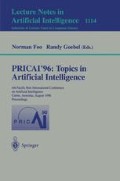Abstract
This paper presents an architecture for task independent autonomous flying vehicles. First, we review the conventional architectures such as the model-and-planner, behavior-based, and the subsumption architectures. Second, we propose a strategic architecture, an adaptive composition of a set of strategic multiagents, which could overcome many limitations of the existing architectures. Each strategy is designated to deal with a task and the composition of strategies tackle more complex task. The proposed strategic architecture maintains a uniform design for its low level control, high level planning, and multi-robot co-operative system thus facilitating strategies' composition and abstraction. This highly modular organization is hardware independent and increases the reusability of strategies.
This research is supported by RGC grant HKUST 610/94E.
Preview
Unable to display preview. Download preview PDF.
References
Nelson C. Baker, Douglas C. MacKenzie, and Stephen A Ingalls. Development of an Autonomous Aerial Vehicle: A Case Study. Journal of Applied Intelligence, 2:271–297, 1992.
J. Britanik and M. Marefat. Hierarchical Plan Merging with Application to Process Planning. In 14th International Joint Conference on Artificial Intelligence, pages 1677–1683, Montreal, Canada, 1995.
Rodney A. Brooks. Intelligence Without Reason. AI Memo No. 1293, Massachusetts Institute of Technology, 1991.
Kazuo Iwano, Prabhakar Raghavan, and Hisao Tamaki. The Traveling Cameraman Problem, with Applications to Automatic Optical Inspection (Extended Abstract). In 5th International Symposium on Algorithms and Computation, pages 29–37, Beijing, China, 1994.
Joseph L. Jones and Anita M. Flynn. Mobile robots: Inspiration to Implementation. A.K. Peters, Wellesley, Massechusettes, 1993.
T. Laengle and T. C. Lueth. Decentralized Control of Distributed Intelligent Robots and Subsystems. In A. Crespo, editor, Artificial Intelligence in Real Time Control, pages 281–286. Pergamon, Oxford, UK, 1994.
Lam-Fan Lee. An Architecture for Autonomous Helicopters. Master's thesis, Department of Computer Science, Hong Kong University of Science & Technology, 1996. in preparation.
Anthony M. Lewis, Andrew H. Fagg, and George A. Bekey. The USC Autonomous Flying Vehicle: An Experiment in Real-Time Behavior-Based Control. In IEEE International Conference on Robotics and Automation, pages 422–449, Atlanta, Georgia, 1993.
Matthew T. Mason. Kicking the Sensing Habit. AI Magazine, 14(1), January 1993.
Donald McLean. Automatic Flight Control Yystems. Prentice Hall, New Jeysey, 1990.
Jane Mulligan. A Proposed Framework for Characterization of Robotics Systems. Technical Report 92-29, Department of Computer Science, University of British Columbia, 1992.
H. Penny Nii. Blackboard Systems. In Avron Barr, Paul R. Cohen, and Edward A. Feigenbaum, editors, The Handbook of Artificial Intelligence, volume 4, pages 1–82. Addison Wesley, 1989.
Randall R. Padfield. Learning to Fly Helicopters. TAB Books, Blue Ridge Summit, PA, 1992.
Phillip C-Y. Sheu and Q. Xue. Intelligent Robotic Planning Systems. World Scientific Publishing, Singapore, 1993.
Richard A. Young. Oh say, can you see? The Physiology of Vision. In SPIE Vol. 1453 Human Vision, Visual Processing, and Digital Display II, pages 92–123, San Jose, California, 1991.
Author information
Authors and Affiliations
Editor information
Rights and permissions
Copyright information
© 1996 Springer-Verlag Berlin Heidelberg
About this paper
Cite this paper
Lee, LF., Kean, A. (1996). An architecture for autonomous flying vehicles: A preliminary report. In: Foo, N., Goebel, R. (eds) PRICAI'96: Topics in Artificial Intelligence. PRICAI 1996. Lecture Notes in Computer Science, vol 1114. Springer, Berlin, Heidelberg. https://doi.org/10.1007/3-540-61532-6_52
Download citation
DOI: https://doi.org/10.1007/3-540-61532-6_52
Published:
Publisher Name: Springer, Berlin, Heidelberg
Print ISBN: 978-3-540-61532-3
Online ISBN: 978-3-540-68729-0
eBook Packages: Springer Book Archive

